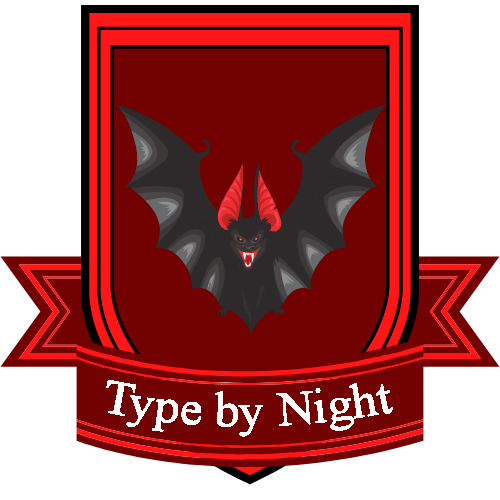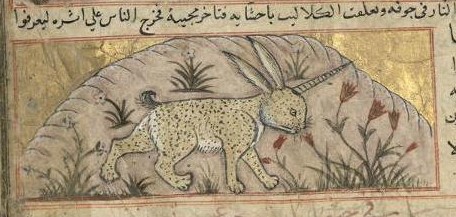Al-Miraj ([ ahl-miʿRAHZH ] | / ɑl mɪˈrɑʒ /)
An al-miraj is a lagomorphic creature with yellow or golden fur, and a spiralling horn like a unicorn's, growing out of the front of its head. It was first recorded in medieval Islamic literature. It is said that all animals that set sight upon it will flee.
Always appreciative of bad jokes and worse puns, modern literomancers have nicknamed the creature the "stabbit," and this has made it into the Urban Dictionary.
Basic Information
Anatomy
The "stabbit" is usually described as a rabbit or hare with yellow fur and a black, spiralling horn, resembling that of a unicorn, which grows out of its occipital bone.
Fur colours seem to range from pale wheat to dun to golden to honey-brown, and may show white patches or even be dappled, striped, or spotted in dark brown, black, or grey. The ears are usually described as being proportionately long, and may be black or brown tipped.
The horn is typically described as having the colour and texture of polished ebony wood.
Otherwise, al-miraj share the usual powerful hind legs, claws, sharp incisors, long ears and fluffy tails of all lagomorphs, allowing them to chew through even the toughest materials given time, evade predators by outrunning and out-hopping them, and fight when they must.
Genetics and Reproduction
Speculation on the possible genetic relationships of cryptid lagomorphs is a hot topic in science currently. Some theories postulate that al-miraj and jackalopes are essentially the same creatures, except for the numbers of horns. Cryptozoologists who have actually seen the two creatures believe otherwise.
However, both al-miraj and jackalopes have 48 chromosomes, like hares, as opposed to the 44 chromosomes of rabbits, meaning they are likely more closely related to hares.
Like other lagomorphs, al-miraj seem to breed frequently and bear many young at once, often from several different bucks. A small fluffle in captivity in Iran breeds from December to September and the gestation period is about six weeks long. Each doe produces up to four litters a year, ranging from one to five kits, which they nurse in shallow dirt nests that are formed by scraping hollows in the ground. These hollows are called "forms" and are typically lined with flattened grass. Whether this is typical of all "stabbits" or not in unknown.
Young are born live, fully furred, and with eyes open, and a soft nub of a horn that begins hardening immediately after birth. Its horn will grow to its full size -- about a third of the length of the al-miraj's body -- within the first year. The horn is not used in scuffles between the creatures, although bucks fight for dominance and mates, just as other lagomorphs do. This appears to be an adaptation strictly for defense of itself and its fluffle against predators.
Some al-miraj are said to have venomous horns, though there is no evidence of that among the captive warren.
Ecology and Habitats
The al-miraj seems to prefer coastal habitats. Its earliest appearance in folklore was associated with the legend of Iskandar (Alexander the Great) who, after defeating the dragon of Dragon Island in the Indian Ocean, obtained the animal as gift from the inhabitants.
Dietary Needs and Habits
Although there is no such thing as a strict herbivore, the al-miraj comes close. Its diet mostly consists of grasses. The captive warren seems to share the archetypal lagomorphic love of carrots and bananas.
The al-miraj will eat a predator it had to fight if it can, however, and this may have given rise to reports that the animal is carnivorous. It is unclear why the al-miraj reacts in this particular way; perhaps the life-and-death conflict produces a "survival mode" instinct, something like how snowshoe hares will scavenge their own predators in the depths of Arctic winters.
Behaviour
The al-miraj appears to be fairly typical of other hares and rabbits; alert, twitchy, responsive to danger in its environment, and preferring flight over fight. Socially, it organizes somewhat between hares and rabbits; while it dwells above ground as hares do, it appears to gather in "fluffles" that interact, scuffle, interbreed, and protect each other from predators.
However, it has one key difference from other lagomorphs; if spotted by its prey, rather than freezing or "playing dead," it will stare the predator down. It dips its head to aim its horn at the threat, meets the possible predator's eyes, and waits. If attacked, it will charge and thrust with its horn before resorting to other lagomorphic fighting methods; biting, clawing, and kicking with its powerful back legs.
While this behaviour has resulted in at least one "stabbit" being run over by a car, it is a surprisingly intimidating behaviour, and may have been the origin of the belief that other animals would flee before an al-miraj.
Additional Information
Uses, Products & Exploitation
Medieval writings suggest that al-miraj are quite tasty, but if anyone has cooked one since their rediscovery, they have been wise enough not to advertise it, considering the public backlash that would likely result.
Geographic Origin and Distribution
Al-mirajs were first re-discovered on a small island in the Persian Gulf. A small population of al-miraj were captured by a fisherman and sold to the Tehran Zoological Garden ("Eram Zoo") in early 2022, where they caused a media sensation. They are still resident at the zoo, funded in part by the Lapin Lagomorph Trust, and are the source of most of the present data available on the creatures.
Since then, al-miraj have been sighted throughout the Mediterranean and Middle East, but most of these sightings appear to be false reports. Confirmed al-miraj have been found elsewhere in the Persian Gulf and Arabian Sea. One has been credibly photographed on Cyprus, but thus far has evaded capture.
Perception and Sensory Capabilities
The al-miraj has all the advantages of a lagomorph's keen senses; keen colour vision, widely-spaced eyes, excellent hearing thanks to its long ears, long whiskers to feel its way in the dark. These all aid the creatures in evading their many predators.
WIP
Streamer
Missing
Status: Location Unknown
Deceased
Status: Deceased Character
Retired
Status: Retired Character or Article
Scientific Name
Lepus conutus monoceros
Origin/Ancestry
It is possible that the jackalope and the al-miraj are closely related. DNA studies are underway, albeit with an extremely limited sample size.
Lifespan
Unknown
Conservation Status
Like most of the new, or recently revived, mythological creatures, the al-miraj is considered critically endangered. House Lapin has listed them among the creatures they will fund protection efforts for under the Lagomorphic Trust.


















You really went for it on this article! Great job! I haven't even written my own article, congrats on beating me to the punch!
Learn about the World of Wizard's Peak. Visit my Worldember 2025 Hub as I work on 50,000 words in December!
I'm looking forward to seeing your article too! Never would have known about this lovely creature without your amazing sketch, so thank you. And double credits to Moonflower for giving us the name "stabbit." :D